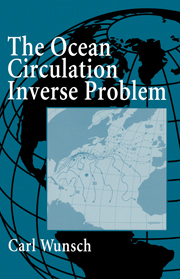1 - Introduction
Published online by Cambridge University Press: 07 May 2010
Summary
Background
Ocean modelers, in the formal sense of the word, attempting to describe the ocean circulation have paid comparatively little attention in the past to the problems of working with real data. Thus, for example, one drives models, theoretical or numerical, with analytically prescribed wind or buoyancy forcing without worrying overly much about how realistic such assumed forms might be. The reasons for approaching the problem this way are good ones-there has been much to learn about how the models themselves behave, without troubling initially about the question of whether they describe the real ocean. Furthermore, there has been extremely little in the way of data available, even had one wished to use, say, realistic wind and buoyancy flux fields.
This situation is changing rapidly; the advent of wind measurements from satellite-borne instruments and other improvements in the ability of meteorologists to estimate the windfields over the open ocean, and the development of novel technologies for observing the ocean circulation, have made it possible to seriously consider estimating the global circulation in ways that were visionary only a decade ago. Technologies of neutrally buoyant floats, long-lived current meters, chemical tracer observations, satellite altimeters, acoustical methods, etc., are all either here or imminent.
The models themselves have also become so complex (e.g., Figure 1–1a) that special tools are required to understand them, to determine whether they are actually more complex than required to describe what we see (Figure 1–1b), or if less so, to what externally prescribed parameters or missing internal physics they are likely to be most sensitive.
The ocean is so difficult to observe that theoreticians intent upon explaining known phenomena have made plausible assumptions about the behavior
- Type
- Chapter
- Information
- The Ocean Circulation Inverse Problem , pp. 1 - 16Publisher: Cambridge University PressPrint publication year: 1996
- 2
- Cited by



